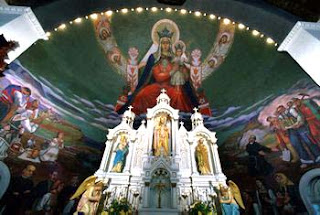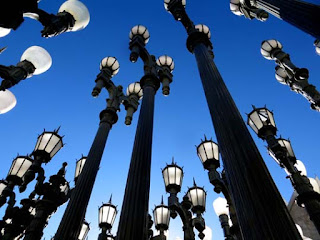 |
| St. Nicholas Church, Millvale, PA with murals by Maxo Vanka |
Seventy-five years ago, Croatian artist Maximilian Vanka completed the murals inside St. Nicholas Church in Millvale, Pennsylvania, a remarkable work of art of both religious and social and political commentary. My parents, Les and Kay Scheaffer, who were graduate students at the University of Pittsburgh at the time, made regular visits to watch Maxo Vanka work. In his retirement, my father wrote about their experience. His story is below. You can see details of some of the murals and learn about them at www.vankamurals.org.
A small bearded man knelt on a scaffold assessing his depiction of an angel. With a paint brush in one hand and hanging onto a rope with the other, he leaned back to get some perspective in the waning afternoon light. Apparently satisfied, he straightened up, put the brush into a number ten can and edged carefully to the end of the scaffold. He climbed down, leaving a void in the ceiling where his silhouette had been a few minutes before. When he reached the floor, he walked over to where we were standing and joined us in surveying his work. For a minute or so, no one said anything, though we were full of questions.
The artist broke the silence after looking closely at each of us.
"Are you brother and sister? You look alike."
"No. We're husband and wife, Les and Kay."
At that point a door opened at the right of the altar and a priest came down the aisle. He reminded the artist that supper was ready. As we started to leave, the artist introduced us as "young married students from the university." He pointed to the priest, saying,
"This is my friend, Father Joseph."
The priest smiled and replied, "And my good friend, Maxo Vanka."
Each had emigrated to America in 1929. Father Joseph had been given a Croatian church in the town of Millvale, near Pittsburgh, and Mr. Vanka had settled in New York City. In 1937, at the request of Father Joseph, Maxo Vanka had agreed to paint the sanctuary of the church with murals. They would depict stories of the Bible, life in Croatia, and life in America.
On the following Saturday we returned to Millvale, entering the church in mid-afternoon. The western sun formed its own scaffold of rays, lighting up the paintings and particularly the Virgin Mary. She was looking at us no matter where we stood or sat in the sanctuary. She was above the altar, not dressed in 16th century Italian finery, but in a brilliant red Croatian wedding dress. The high neck gown was decorated with yellow, green, and red braid, from her collar down to her dark blue slippers. There were only three of us in the church--Kay and I and Mr. Vanka, or four if you count Mary.
We turned to the south wall depicting the Croats in America: A family around a kitchen table, a group of men at work in a steel mill, and a Sunday picnic at the river park. Kay pointed to a pretty little girl, nine or ten years old, who appeared in the family mural scenes.
"Who is the little girl?"
Mr. Vanka could not have been more pleased that she had noticed the pretty little blonde girl with two braids over her shoulders. "That's Peggy, my ten year old daughter. She's an American girl, home with her mother while I'm working here. I miss her and her mother very much."
Then we asked about the little bird that appeared in so many of the paintings.
"That's Pepralitsa, the bird who flew into my studio one day, very frightened until I talked to her and told her about my garden in Zagreb. I gave her part of my sandwich and she never left. That is, I left the window open a little bit so she could come and go as she wished and she kept coming back. I would carry bread crumbs and millet seeds in the breast pocket of my smock. I showed her the way, and she would spend a lot of time in my pocket--her nest."
"Let me tell you a funny story about Pepralitsa. One day I was invited to a dinner party preceding the opening of a show in my honor. Mrs. Vanka was invited too, and assumed that I would wear a tuxedo, it being a formal occasion. I did put on all the formal wear except the tuxedo jacket. I thought it would be fun, and what people might expect of an artist, if I wore my painting smock instead of the black tuxedo jacket. Mrs.Vanka thought this was rather bizarre but reluctantly gave in to my arguments. I didn't tell her that Pepralitsa had been sleeping in my pocket for several nights and would also be going along to the dinner party. Well, things went along fine through the reception, and, as I had speculated, the ladies in particular seemed to like the idea of an eccentric artist in their midst wearing a clean but paint smudged smock to a formal dinner. Perhaps they assumed that the bulging breast pocket contained a paint cloth or some tubes of paint. But then at dinner it happened--Pepralitsa got hot or curious, popped out of my pocket onto my shoulder, then flew across the table to light on the head of an older lady who had spent the evening trying to impress me with her knowledge of art. With Pepralitsa dancing in her hair she let out a scream that even frightened my little bird. Pepralitsa came back to my shoulder and after a gentle scolding I gave her some crumbs and told her to stay in my pocket. The lady calmed down, but Mrs. Vanka wasn't too pleased with her eccentric husband."
After his story, Mr. Vanka excused himself and climbed back onto his scaffold.
We came back many times, getting better acquainted with Mr. Vanka and also with Father Joseph.
It was Father Joseph who, over tea one evening, told us about the early days of the Millvale church when Father Albert was the priest:
"Father Albert came to America in 1914 soon after the Sarajevo incident and the outbreak of war in Europe. He was sent to Pennsylvania and given a mission church in our smoky little city on the river. Millvale already had a number of Croatian immigrants, and more were coming all the time. They soon outgrew the little Catholic church and it was Father Albert's job to plan and raise money for a larger one. Some money came from the diocese but much of the money was wheedled out of his parishioners.”
“Some people thought that he demanded too much from his church members who had large families to support and worked for low wages in the steel mill. They didn't dare complain to the priest but somehow gossip got back to him and he didn't like what he heard. Some people said his sermons were too long, and that he was always scolding the congregation. Perhaps much of this was pure gossip, but it was clear that Father Albert was not much loved by his flock, and he knew it.”
“This went on for fifteen years, and then the worst thing happened--the Bishop came to him, before he was even seventy years old, and suggested that it was time for him to retire. So with much bitterness, Father Albert left the church.”
“Soon after Father Albert retired, he passed away. Some people say he died of a broken heart. I came to America after he was gone and buried, and therefore never met him. Mrs. Velazic swears that he came to one of my evening services, but she was the only one who saw him. She said he floated down the aisle waving his arms and shaking his fist at me. She even thinks he tasted the communion wine and then vanished through the west wall. Of course, Mrs. Velazic was an old lady, in her eighties, and never did see too well."
We asked Father Joseph, "Did you ever tell that story to Mr. Vanka?"
"No, no! There are enough mysteries in life without adding any more." And then with a little nervous laugh, he said, "Maxo does a lot of painting at night. He has to keep his mind on his work to meet our Easter deadline."
It had been eleven years since Father Albert had seen his church, eleven years of purgatorial expiation, free-floating around Millvale. However, time and mortality were no longer factors with Father Albert. Tonight he would visit the church just to alleviate his loneliness and to make sure that things hadn't changed too much. It was 11:30 when he went in. He knew there would be an altar light, but he didn't expect to see a spotlight focused on the ceiling, nor a scaffold, nor a man on the scaffold painting pictures-spoiling his church. Father Albert thought, No one consulted me about this, painting my church with all these pictures. I'll talk to the Bishop about it. He glided down the center aisle, studied the murals, and shook his fist at Mr. Vanka.
Maxo heard nothing but sensed that someone was in the church. He looked down and saw the priest. He saw him face the scaffold and shake his fist. He saw him taste the communion wine--and then disappear through a closed window. Maxo was shaken by what he saw. He went back to work, but left the church early.
After the same thing happened four nights in a row, Maxo told Father Joseph about it and then heard the story of Mrs. Velazic's vision. Father Joseph suggested that Maxo take a few days' rest, that he go home to see his family and then come back to finish the murals.
It was three weeks before we were able to get back to Millvale. Mr. Vanka was not on the scaffold. We decided to go see Father Joseph. As we sipped coffee, Father Joseph answered our question:
"Mr. Vanka has been working too hard, too many late nights, he needed a rest. It seems that Father Albert has been visiting the church at night, bothering Mr. Vanka. Maxo went home but he'll be back."
At that point the housekeeper came in--"Father, The Bishop is on the phone."
"Excuse me, friends, while I take this call. The Bishop has been worried about a call he got a few days ago, some `crank' impersonating Father Albert--after all these years!"
Mr. Vanka came back in a few days, and from then on painted only in the daytime. He completed the work by the middle of March. On Easter morning, 1942, the murals were blessed by the Bishop.



































